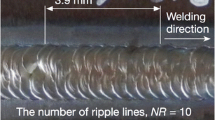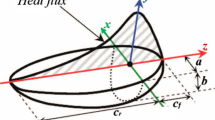Abstract
The welding with weaving has been used widely to obtain better weld quality by avoiding lack of side wall fusion and improve the weld efficiency by obtaining the wide weld bead. But the effect of weave frequency and weave amplitude on the temperature field is not clear. In the present paper, a coordinate transformation method is put forward to simulate the weave welding process. The temperature distribution during the welding with weaving under different weave parameters are compared and discussed. Comparison between experimental and simulation results reveals a good agreement. The peak temperature and the average temperature in weld seam center decreased due to the increasing of the weave amplitude and weave frequency. But the weave frequency has less effect on the average temperature.
Similar content being viewed by others
References
Zhu X, Chao J (2004) Numerical simulation of transient temperature and residual stresses in friction stir welding of 304L stainless steel. J Mater Process Technol 146(2):263–272
Adak M, Soares CG (2013) Effects of different restraints on the weld-induced residual deformations and stresses in a steel plate. Int J Adv Manuf Technol 1–12
Deng D, Murakawa H (2006) Numerical simulation of temperature field and residual stress in multi-pass welds in stainless steel pipe and comparison with experimental measurements. Comput Mater Sci 37(3):269–277
Lin Z, Li Y, Wang Y, Chen G (2005) Numerical analysis of a moving gas tungsten arc weld pool with an external longitudinal magnetic field applied. Int J Adv Manuf Technol 27(3–4):288–295
Deng D, Murakawa H (2013) Influence of transformation induced plasticity on simulated results of welding residual stress in low temperature transformation steel. Comput Mater Sci 78:55–62
Attarha MJ, Sattari-Far I (2011) Study on welding temperature distribution in thin welded plates through experimental measurements and finite element simulation. J Mater Process Technol 211(4):688–694
Varghese VJ, Suresh MR, Kumar DS (2013) Recent developments in modeling of heat transfer during TIG welding—a review. Int J Adv Manuf Technol 64(5–8):749–754
Fang H, Meng Q, Xu W, Ji S (2005) New general double ellipsoid heat source model. Sci Technol Weld Join 10(3):361–368
Goldak J, Chakravarti A, Bibby M (1984) A new finite element model for welding heat sources. Metall Trans B 15(2):299–305
Mackwood AP, Crafer RC (2005) Thermal modelling of laser welding and related processes: a literature review. Opt Laser Technol 37(2):99–115
Li J, Li L, Stott F (2004) Comparison of volumetric and surface heating sources in the modeling of laser melting of ceramic materials. Int J Heat Mass Transf 47(6):1159–1174
Engelhard G, Habip LM, Pellkofer D, Schmidt J, Weber J (2000) Optimization of residual welding stresses in austenitic steel piping: prooftesting and numerical simulation of welding and postwelding processes. Nucl Eng Des 198(1):141–151
Chang WS, Na SJ (2002) A study on the prediction of the laser weld shape with varying heat source equations and the thermal distortion of a small structure in micro-joining. J Mater Process Technol 120(1):208–214
Sabapathy PN, Wahab MA, Painter MJ (2000) The prediction of burn-through during in-service welding of gas pipelines. Int J Press Vessel Pip 77(11):669–677
Hu J, Yang J, Fang H, Li G, Zhang Y (2006) Numerical simulation on temperature and stress fields of welding with weaving. Sci Technol Weld Join 11(3):358–365
Fachinotti VD, Anca AA, Cardona A (2011) Analytical solutions of the thermal field induced by moving double–ellipsoidal and double–elliptical heat sources in a semi–infinite body. Int J Numer Methods Biomed Eng 27(4):595–607
Parkitng R, Winczek J (2010) Analytical solution to transient temperature field in a half-infinite body caused by moving volumetric heat source. Int J Heat Mass Transf 53(25):5774–5781
Roshyara NR, Wilhelm G, Semmler U, Meyer A (2011) Approximate analytical solution for the temperature field in welding. Metall Mater Trans B 42(6):1253–1273
Author information
Authors and Affiliations
Corresponding author
Rights and permissions
About this article
Cite this article
Chen, Y., He, Y., Chen, H. et al. Effect of weave frequency and amplitude on temperature field in weaving welding process. Int J Adv Manuf Technol 75, 803–813 (2014). https://doi.org/10.1007/s00170-014-6157-0
Received:
Accepted:
Published:
Issue Date:
DOI: https://doi.org/10.1007/s00170-014-6157-0




